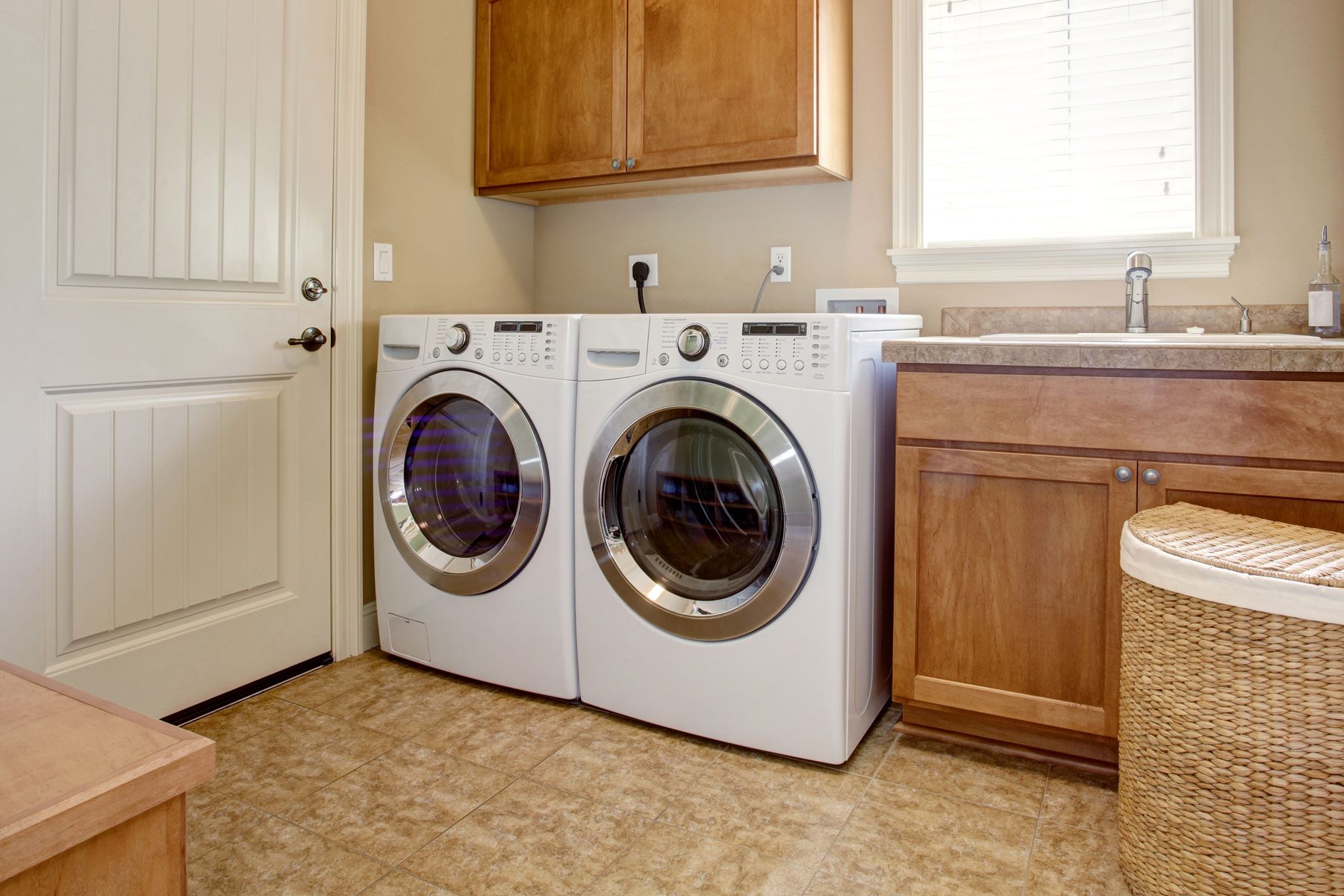Worried about water problems from your upstairs washing machine? Here's how to prevent overflows and leaks.

How To Avoid a Flooded Laundry Room Upstairs

I applaud architects who create second-floor laundry rooms since they’re usually on the same level as the bedroom. That makes them so convenient because you don’t have to haul clothes up and down the stairs. But that perk comes with a dark side—when something goes wrong, it can create a disastrous mess.
“We get calls for flooded laundry rooms all the time,” says Josh Rudin, owner of ASAP Restoration. “Usually, it has something to do with the hoses, either the water supply line or the transport line, which ejects the spent water into your sewage system.”
Whether that’s your issue or something else, it’s often pretty easy to prevent laundry room flooding. Here’s how.
On This Page
What Causes Laundry Room Flooding?
The most common causes of a leaking or flooding washing machine include:
- The hoses on the back of the washer dislodge, rupture or disconnect from the unit.
- A floor drain is clogged.
- A valve is loose or has a faulty seal.
- On rare occasions, the machine itself fails.
“It could also be because you put too much clothing in the washing machine or too much detergent,” says Melanie Powers, president at Goodberlet Home Services.
Tips to Prevent Laundry Room Flooding

Maintain the Hoses
Be vigilant about securing, maintaining and replacing worn-out or cracked hoses and tubing on your washing machine. “In some environments, these hoses and tubes will only last a few years before they begin to show signs of wear and tear,” says Rudin. “That can lead to ruptures when pressurized or during draining.”
When you buy new washing machine hoses, consider no-burst versions, which are sheathed with braided stainless steel, and also install new hose washers. Hand-tighten the hoses, then turn the water on and check for leaks. If necessary, tighten further by hand or with pliers.
Wash Responsibly
Wash smaller loads with less detergent, and clean filters and drains regularly.
Install a Moisture Meter and/or Recessed Washer Box
A moisture meter connected to a shut-off control valve or a recessed washer box in the wall directly behind the washing machine can help stop leaks before they do significant damage. Recessed boxes feature plumbing fittings with shutoff valves for the water supply hoses and a drain for the washer’s discharge hose.
For easy access and servicing, mount the bottom of the box at about the same level as the top of the washing machine control panel. Be sure to choose a box with shutoff valves included.
Create a Catch Basin
To prevent laundry room flooding, there are encapsulating systems, which are essentially basins to catch the water from the machine, or in some instances the entire room, and either hold it or transport it out of the area. “This can help prevent flooding, but it doesn’t necessarily mean it is totally out of the realm of possibilities,” says Rudin.
One example of this is a drain pan under the washer, which can be plumbed directly into your home’s waste line or diverted to a laundry tub, floor drain, or outside through the walls. Be sure it’s tight against the framing of the back wall, and run the drywall down to it.
Turn Off the Water
A practical way to prevent a flooded laundry room is to turn off the water to the supply hoses when the washing machine isn’t in use. This is best accomplished by installing a single-lever shut-off valve on the supply hoses or purchasing a recessed washer box with one built in.
How to Clean Up a Flooded Laundry Room
If the flooding just happened and isn’t severe:
- Unplug everything and shut off the water.
- Remove excess water from the floor using towels or a wet-dry vacuum.
- Let the area dry completely to prevent mildew and mold. A fan or dehumidifier can help.
If you didn’t catch it quickly, or if there is a huge amount of water, then moisture could have traveled down into the walls and the floor/ceiling. Depending on your climate, that could cause mold. In this case, you may need to remove carpeting, cut drywall up two feet past the flood mark and sand down studs in the walls to prevent mold contamination from taking hold, says Rudin.
Why Does My Laundry Room Keep Flooding?
If your laundry room repeatedly floods, it could be a number of issues, including a dislodged or leaky hose, a clogged drain, a loose valve, a failing washing machine or loads that are overstuffed or with too much detergent.
“Flooding that happens regularly is a problem that needs to be addressed immediately before more damage occurs and before mold growth gets out of control,” says Rudin.
If your laundry room is experiencing regular leaks, then it could be a problem with the washing machine fittings, a worn gasket, a damaged washer or a problem with the water line.
When To Call a Pro
If you can’t figure out what’s leaking, or if you’ve had a large flood you suspect has permeated into the walls or floor, it’s probably time to call a pro to remedy the problem promptly before mold becomes an issue. Water damage technicians have access to air movers, dehumidifiers and water extraction tools that aren’t readily available to consumers.
“Cleaning up an upstairs laundry room flood is a challenging task, and this is why people usually make an insurance claim and then call professionals to do the work for them,” says Rudin.
About the Experts
- Josh Rudin is the owner of ASAP Restoration in Tempe Arizona. He started the company as a one-man operation in 2008, and today it has grown into one of the city’s top disaster mitigation specialists.
- Melanie Powers is president at Goodberlet Home Services, a female-owned plumbing, construction, electrical and HVAC repair company, serving parts of Illinois and Indiana since 1982.




















